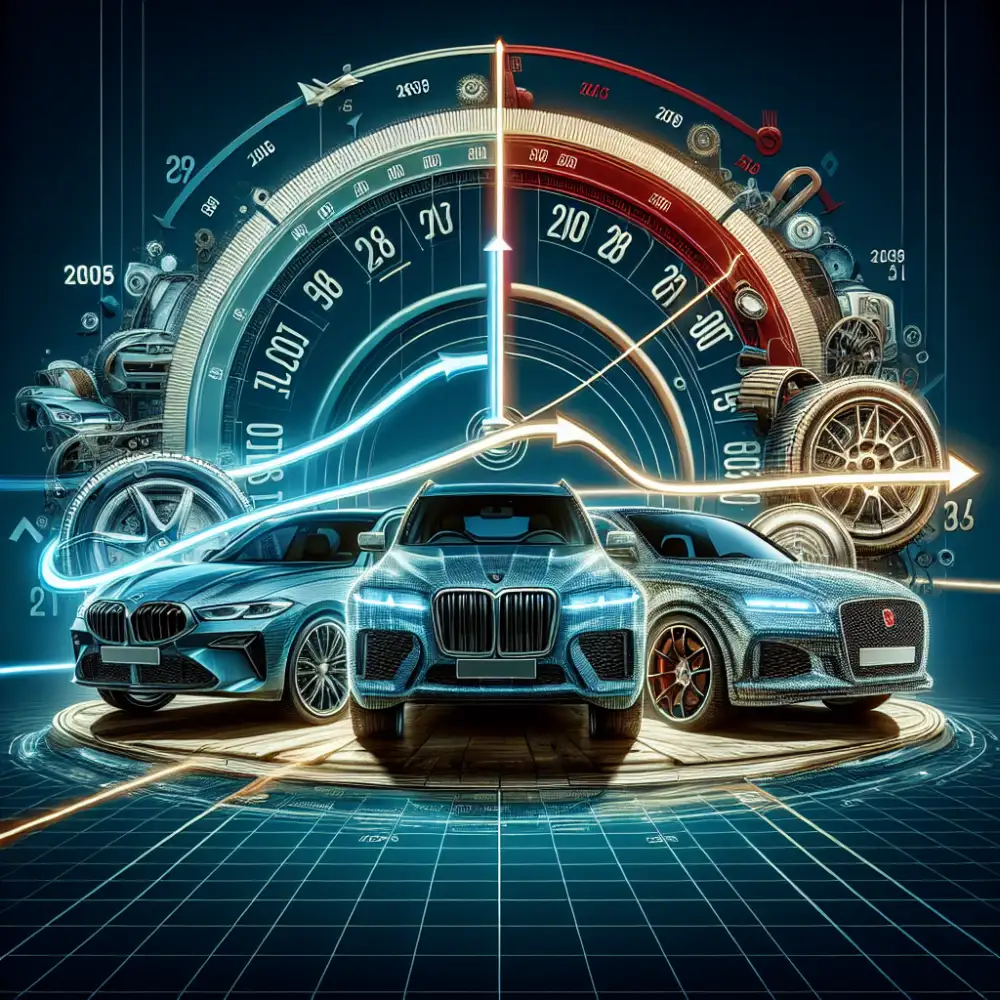The Best BMW X5 Years: A Definitive Ranking

The BMW X5, a pioneer in the luxury SUV segment, has been a popular choice for drivers seeking a blend of performance, practicality, and prestige. Over the years, BMW has released several iterations of the X5, each with its own set of improvements and refinements. Determining the "best" model year can be subjective, as different drivers prioritize different aspects of a vehicle. However, some model years stand out due to their exceptional reliability, performance, technological advancements, or a combination of these factors. This article aims to provide a comprehensive ranking of the best BMW X5 model years, considering factors such as reliability ratings, common problems, performance upgrades, technology features, and overall owner satisfaction. Whether you're in the market for a used BMW X5 or simply curious about the evolution of this iconic SUV, this ranking will serve as a valuable resource.
Methodology
To determine the best BMW X5 model year, we took a comprehensive approach, considering factors that are most important to potential buyers. This includes reliability, safety ratings, owner satisfaction, performance, and standout features for each model year.
We delved into reputable automotive sources like J.D. Power, the National Highway Traffic Safety Administration (NHTSA), and IIHS. These sources provided valuable data on reliability ratings, safety scores, and common owner-reported issues.
Furthermore, we analyzed expert reviews and owner forums to understand the strengths and weaknesses of each model year. This qualitative data helped us gauge owner satisfaction, identify recurring problems, and highlight exceptional features or performance aspects.
By combining both quantitative data from reputable organizations and qualitative insights from experts and owners, we were able to rank the BMW X5 model years effectively. This methodology ensures a balanced and well-rounded assessment, allowing us to confidently recommend the best BMW X5 model years for prospective buyers.
Third Generation (F15: 2014-2018)
The third generation of the BMW X5, known as the F15, ran from 2014 to 2018. This iteration offered a range of engine options, including a new turbocharged four-cylinder engine in the sDrive25d model, a first for the X5 line. While this generation didn't see a significant redesign, it did receive some notable updates, including a revised exterior with a more sculpted look and a refreshed interior with upgraded materials and technology.
When considering the best model year for the BMW X5, the 2016 model often stands out. It benefits from the mid-cycle refresh introduced for the 2014 model year, offering a good balance of features, performance, and reliability. The 2016 model also introduced Apple CarPlay, a desirable feature for many buyers.
However, other model years within the third generation also have their merits. For instance, the 2018 model year, being the last of this generation, often comes equipped with more standard features and may offer a good value proposition on the used car market. Ultimately, the best BMW X5 model year for you will depend on your individual needs and preferences, as well as your budget.

Second Generation (E70: 2007-2013)
The second generation of the BMW X5, known as the E70, was produced from 2007 to 2013. This iteration saw significant advancements in technology, performance, and luxury. The E70 was the first X5 to offer a third-row seat, increasing its practicality for larger families.
While the E70 was generally well-received, some model years stand out for their reliability and performance. The 2011-2013 model years are often considered the most desirable within the E70 generation. These later models benefited from refined engines and transmissions, addressing some of the issues found in earlier E70s.
Specifically, the 2011 X5 introduced a new turbocharged eight-speed automatic transmission, improving both acceleration and fuel economy. However, it's important to note that even within the most reliable years, individual vehicle history and maintenance play a crucial role in long-term dependability.
Fourth Generation (G05: 2019-Present)
The fourth generation of the BMW X5, known as the G05, debuted in 2019. It boasts a more sculpted exterior design and a luxurious, tech-laden interior. The iDrive infotainment system is one of the best in the business, and the X5 offers a wide range of powertrain options, including a plug-in hybrid. When considering the best model year for the BMW X5, the G05 generation consistently ranks high.
Here's a possible ranking:
2022-Present: These model years benefit from minor updates and refinements, making them a great choice.
2021: This model year saw the introduction of a new 48V mild-hybrid system for improved fuel efficiency.
2020: As the second year of the G05 generation, the 2020 model addressed any initial issues and offered a strong package.
2019: While the first year of a new generation can sometimes have teething problems, the 2019 X5 was generally well-received.
Ultimately, the best BMW X5 year for you depends on your budget and priorities. Newer models offer the latest technology and features, while earlier G05 models provide excellent value on the pre-owned market.
First Generation (E53: 1999-2006)
Launched in 1999 for the 2000 model year, the E53 X5 was BMW's first foray into the SUV market. It was met with instant success, praised for its car-like handling and powerful engine options. However, being a first-generation model, it wasn't without its issues. Early models, particularly those from 1999-2001, were known to have reliability problems, especially with their electronics and automatic transmissions.

Many enthusiasts and mechanics consider the 2004-2006 X5s to be the most reliable of this generation. By this time, BMW had ironed out many of the early issues, and these models benefited from several updates and refinements. They also offered a wider range of engine choices, including the powerful 4.8is model.
While the E53 may not be as luxurious or technologically advanced as later X5 generations, it still holds a special place in the hearts of many BMW enthusiasts. It was a game-changer that paved the way for the luxury SUV segment as we know it today.
Reliability and Common Issues
When it comes to reliability, the BMW X5 has had its share of ups and downs throughout the years. Some model years are considered more reliable than others. Generally, the X5 models from the E53 generation (1999-2006) and the F15 generation (2014-2018) tend to have a less favorable reliability record compared to other generations.
Common issues reported with these models include problems with the cooling system, electrical gremlins, and suspension components. On the other hand, the E70 generation (2007-2013) and the current G05 generation (2019-present) are often praised for their improved reliability.
However, it's important to note that even within a highly-rated generation, there can be variations in reliability depending on factors such as maintenance history and individual vehicle usage. Regular maintenance, including timely oil changes, fluid flushes, and inspections, is crucial for maintaining the reliability of any BMW X5 model year.
While the BMW X5 offers a luxurious driving experience and impressive performance, it's essential to be aware of potential reliability concerns. Conducting thorough research, considering model year reliability ratings, and factoring in the cost of potential repairs can help you make an informed decision when choosing a BMW X5.
Price and Value
When considering a BMW X5, it's essential to weigh price against value. The model year significantly impacts both. While newer models offer the latest technology and styling, they come at a premium. Older models, particularly those known for reliability like the 2011-2013 X5s, can offer exceptional value. These models provide a balance of features, performance, and dependability at a more accessible price point.
| Model Year | Pros | Cons | Reliability Rating (out of 5) |
|---|---|---|---|
| 2014-2018 (F15) | Wide range of powerful and efficient engines, Available with third-row seating, Good balance of comfort and handling | Some early models had issues with the N55 engine, Infotainment system can be slow at times | 3.5 |
| 2019-Present (G05) | Luxurious interior with advanced technology, Powerful engine options, including a plug-in hybrid, Improved handling and performance | Can be expensive, especially with options, Some find the styling to be less distinctive than previous generations | 4 |
Remember, depreciation plays a role. A well-maintained older X5 can still provide years of enjoyable driving experience at a fraction of the cost of a new one. Researching common issues for specific model years is crucial to avoid unexpected repair costs down the line. Ultimately, the best BMW X5 year for you depends on your budget and priorities. If you seek the newest features and are less concerned about price, a newer model is ideal. However, if you prioritize value and reliability, exploring the highly-rated older models like those from the 2011-2013 range might be the smarter choice.

Ultimately, the "best" BMW X5 year depends on individual needs and priorities.
If reliability and value retention are paramount, the E53 generation (especially the facelifted models) presents a compelling case. For those seeking cutting-edge technology and a luxurious experience, the newer G05 generation is hard to beat.
No matter the year, the BMW X5 consistently delivers a potent blend of performance, luxury, and practicality. Thorough research, including expert reviews, owner forums, and reliability data, is crucial to making an informed decision. Consider factors like intended use, budget, and desired features to determine the ideal BMW X5 model year for you. Happy driving!
Published: 06. 07. 2024
Category: Food



